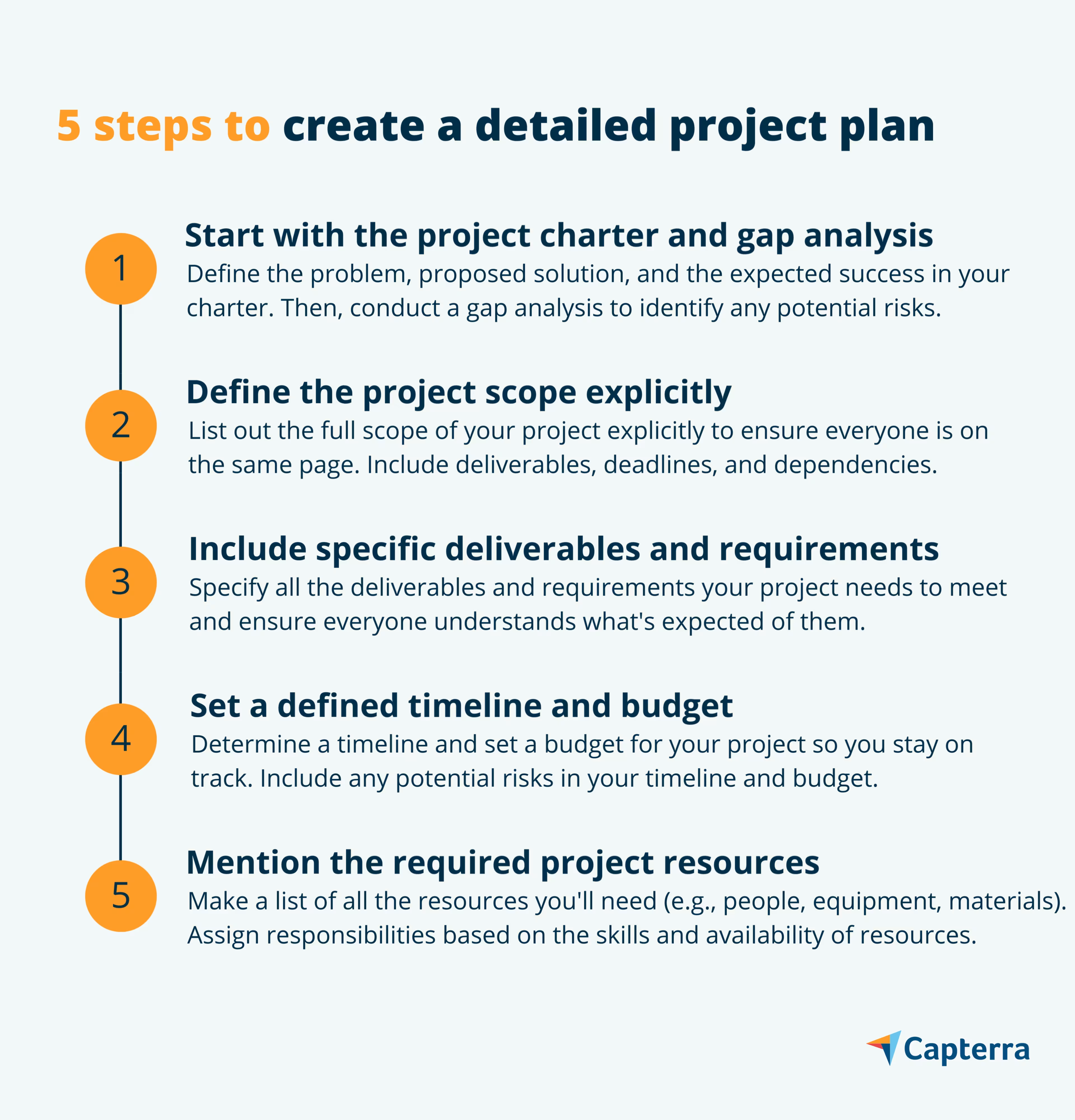Meet deadlines and stay on track with a well-constructed project plan.
Creating a project plan can be challenging and time-consuming even if you've made one before. Every project is different and, therefore, requires a unique approach. As per a Capterra Survey,* project managers spend an average of 17% of their day on the project planning process.
If you’re a small and midsize business (SMB) leader or project manager looking to ensure timely project execution, having a well-written project plan is fundamental. A detailed plan will keep your project on track and allow you to monitor progress, ensuring your project is completed on time and within budget.
In this article, we explain five steps to write a project plan that drives actual results and share tips to make the most of the plan. We also provide a free project plan template with pre-built sections that you can simply plug your data into and start using.
Project Plan Template
Before we get into the details of how to create a project plan, let's take a moment to understand what a project plan is, why it's important, and when you should use it.
What is a project plan?
A project plan is a roadmap that contains all the details of your project. It outlines the scope, timeline, milestones, tasks, and budget required to complete your project successfully. Simply put, it tells you and your team where the project should go and how to get there.
A well-defined project plan helps keep your project team on track and ensures everyone understands their roles and responsibilities. With a project plan, you can easily:
Track project progress and identify potential risks
Strengthen communication among project team members
Save time by having all the project details in one place
Use the plan as a reference for future projects
You should create the plan during the early phases of your project, such as initiation or planning. Whether it's a small internal project or a large-scale initiative, a well-laid project plan will give you a clear overview, ensure smooth execution, and help avoid costly mistakes.

1. Start with the project charter and gap analysis
Before writing the project plan, you must first create the project charter, which is a document that includes your project's objectives, deliverables, timeline, budget, and other crucial details. The charter helps define your project’s scope and sets the foundation for your project plan. It should be created during the initiation phase to get sign-off from each project stakeholder.
To make your project charter comprehensive, perform a gap analysis. Gap analysis will help you identify potential risks as well as the difference between the current and desired states so you can understand what needs to be done to achieve your project's objectives.
For example, if you're redesigning a website, your gap analysis might look something like this:
Current state: The website is outdated and not mobile-friendly.
Desired state: A modern, responsive website that is easy to use on all devices.
Gap: The website needs to be redesigned and developed to be responsive.
Tips to ace this step
Clearly define the project budget, deliverables, deadlines, and other crucial details.
Get the charter approved by stakeholders before you start writing the project plan.
Make sure your gap analysis is detailed and up to date.
To create the charter and conduct a thorough gap analysis, use project management software that offers features such as charter templates and mind mapping.
Our free project charter and gap analysis template comes with pre-filled sections to help you get started. Download it here.
2. Define the project scope explicitly
To create a detailed and specific plan, you need to be explicit about your project's scope, which defines what's included and what’s not in the project deliverables.
For example, for a website redesign project, the scope might look something like this:
What’s included: Designing a new homepage and new landing pages.
What’s not included: Developing a new blog page.
Be as specific as possible about the scope in your project management plan. This will make it easier for everyone to know what exactly should or shouldn’t be delivered. It’ll also help reduce scope creep, which can lead to cost and time overruns.
Tips to ace this step
Communicate the project scope to all stakeholders so everyone is on the same page.
Be sure to get stakeholder sign-off so there’s no scope creep later.
Use our project plan template that includes a project scope section where you can list out project descriptions, objectives, final approvals, and more.
3. Include specific deliverables and requirements
To make your project plan actionable, specific, and measurable, include detailed deliverables and requirements. This will allow the project team members to better understand what needs to be done, by when, and how. By doing this, you can also better track the project progress and make course corrections if needed.
For example, if the deliverable for a website redesign project is to design a new homepage, your requirement might look something like this:
The design must be modern, responsive, and mobile-first.
The colors should be in line with the company's brand guidelines.
The home page should include a prominent hero image and call-to-action (CTA) button.
Tips to ace this step
Break down large deliverables into smaller tasks or milestones.
Make sure the list of requirements is comprehensive and realistic.
Include checkpoints for each deliverable to track progress.
Use requirements management software to capture, track, and prioritize project requirements for creating an actionable project plan.
Download our project plan template, which has a dedicated section for deliverables and requirements. All you need to do is fill in the predefined fields with your project's specific details.
4. Set a defined timeline and budget
Estimating an accurate timeline and budget for your project is crucial to its success. If you don’t set a definite timeline and budget, you may face difficulty tracking progress and ensuring your project is completed on time and within budget.
To estimate the timeline, break down the entire project into smaller, more manageable tasks. This will give you a better idea of how long each project task will take to complete. Also, when assessing the budget, include all necessary costs such as labor, materials, and overhead.
Tips to ace this step
Get input from all stakeholders when estimating the project timeline and budget.
Use budgeting software to better handle your project's finances and costs.
Employ Gantt chart software to better visualize your project schedule and budget.
Download our ready-to-use timeline and budget template to accurately estimate project costs and time and to make necessary changes along the way.
5. Mention the required project resources
Identify all the resources required to complete your project, and add them to your project management plan. Resources can be anything from people (e.g., project manager, software developer, web designer) to equipment (e.g., computers, software licenses) and materials (e.g., stationery, office supplies).
When listing the resources required for your project, be sure to include:
The number of resources required
The specific skills required
The time commitment required from each resource
Once you've listed your project’s resources, the next step is assigning specific tasks to each resource based on their skills, expertise, and experience. Doing this will help you better utilize your resources and ensure project success.
Tips to ace this step
Ensure the resources you’re assigning are up for the challenge and have the necessary skills and expertise.
Use resource management software to create a work breakdown structure (WBS) for your project, streamline project task management, and track the time spent on each task.
Use our project plan template, which has a pre-built resource plan section, to easily organize your resources and track their usage.
Increase planning accuracy with our free project plan template
A lot goes into writing a project management plan, and if you're not careful, it's easy to miss out on important details. To help avoid that and make your job easier, we've created a ready-to-use project plan template that will save you time and increase your project planning accuracy.
With our template, you can:
Create a charter and perform a gap analysis to better understand your project's goals and objectives.
Define your project scope and deliverables using a DACI matrix.
Include detailed deliverables and requirements to track and measure the progress of your project.
Estimate an accurate project budget and timeline to avoid any cost or time overruns.
Identify all required resources and assign specific tasks to each resource to better utilize their skills and bandwidth.
